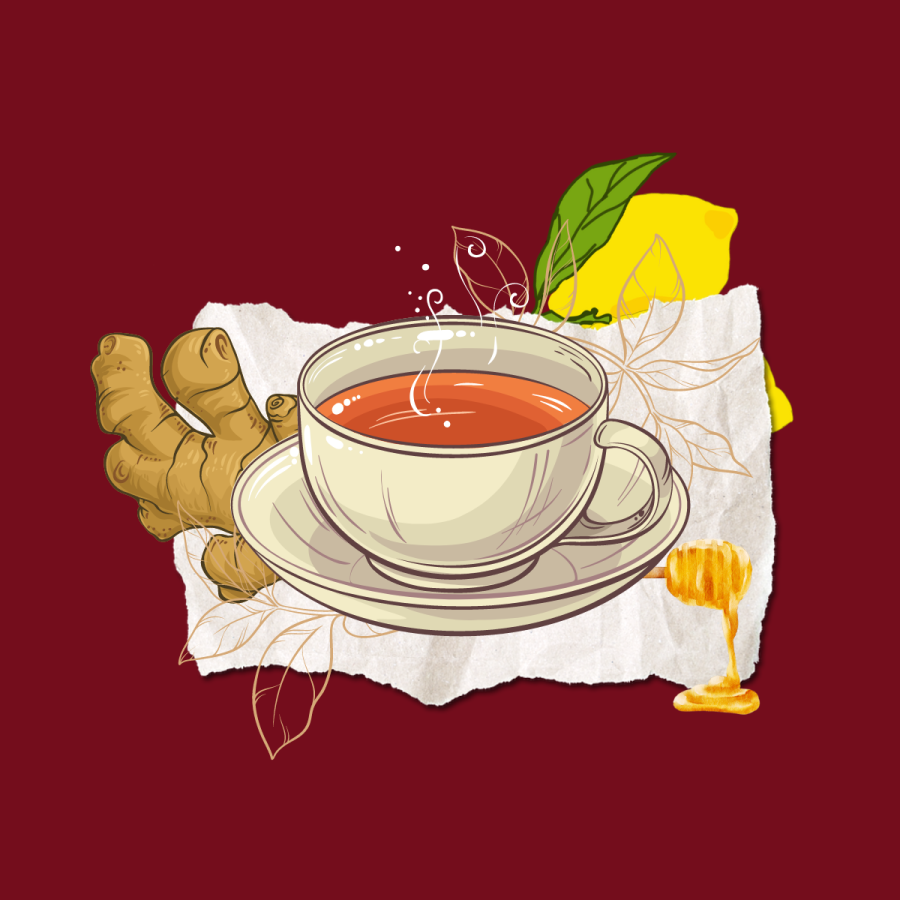Cooking to Cure: Tas-tea remedy
Icky medicine, balled-up tissues next to your bed, chills and aches that perpetually plague your weakened body–there’s no denying that the fall flu means misery.
There’s one day every fall when most of us get that sinking feeling: inhale and your nostrils feel a little cold, your shoulders feel a little tense, your throat feels a little hoarse and your face feels a little clogged.
“Oh, please, don’t let me be sick,” you think.
The following morning, you can’t even step out of bed. You look ahead to the next five days with dread and despair. However, by adjusting your diet to accommodate for your depleted immune system, you can eat meals to feel warm and nourished while also speeding up your healing. There are lots of foods that can help you kick your cold to the curb besides the classics like orange juice and chicken soup.
There are several breakfast options to cook up when you or a loved one is sick. If you hate orange juice, but need vitamin C to kickstart your recovery, you’re in luck. Lots of fruits like cherries, cantaloupe, strawberries and kiwis are also high in vitamin C, which is an antioxidant that fosters immune health. Berries are specifically advantageous because they contain anthocyanins, which “have strong anti-inflammatory, antiviral and immune boosting effects,” according to Healthline.
A study published in 2016 by the American Society for Nutrition found that consistent intake of flavonoid supplements decreased days people were sick by 40%. You can boost a bowl of berries by adding them to some yogurt, which contain probiotics that prevent and/or heal infection and inflammation. You could also have your berries with a bowl of oatmeal because it contains beta-glucan, which is an anti-inflammatory fiber and is soft and gentle on the throat.
Add some bananas to that scrumptious bowl to profit from their potassium content which replenishes your depleted electrolyte levels. And instead of sugar, top it all off with some honey, which is gentle on the throat.
And for a lunch or dinner?
According to FoodData Central, a nutrition database from the United States Department of Agriculture, salmon is a helpful source of protein that is rich in omega-3 fatty acids, which aid the immune system with their anti-inflammatory properties.
You can add sauteed spinach or other veggies as a side dish to the salmon to reap the benefits of their polyphenols. Polyphenols are an organic compound found in dark green vegetables, which, according to Healthine, “act as antioxidants to protect cells from damage and help fight inflammation.”
Chili peppers can be added to your soups, stews and stir-frys to relieve nasal congestion because they contain capsaicin, an active property that thins mucus and relieves congestion and itching. Capsaicin is often found in nasal spray medicines, but you can use it in its organic form to reap all the same benefits, in a more delicious way.
To go along with those tasty entrees is a drink that my mom has brewed for me every year when flu season rolls around: hot honey ginger tea. It’s warm and smooth with a little bit of a kick. It soothes my throat and clears my sinuses and even boosts my mood. Ginger heals a cold because of its gingerol content, which is an anti-inflammatory antioxidant. Honey soothes a sore throat. Sipping from a warm mug, wrapped in my coziest blanket, I’m always comforted by this delicious tea. comforts me, even when I’m not suffering from a cold.
Hot Honey Ginger Tea
Ingredients:
2 cups of water
½ inch fresh ginger, peeled and sliced
1 tablespoon of honey
½ tablespoon of lemon or lime juice
Instructions:
- Add the water to a small pot over medium-high heat, until boiling.
- Add the sliced ginger, and turn down the heat to low, so it’s no longer simmering.
- Cover and let soak for 10 minutes.
- Remove from heat. Strain the tea to remove all ginger pieces.
- Stir in the honey and citrus juice.
Bon appetit!
Skye is a fourth-year philosophy major/psychology minor and reporting intern for The University Times. She has also been featured in the Larchmont Chronicle....





